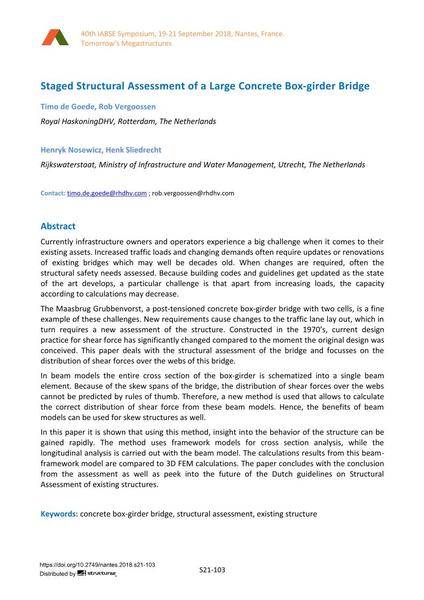Staged Structural Assessment of a Large Concrete Box-girder Bridge

|
|
|||||||||||
Bibliographic Details
| Author(s): |
Timo de Goede
(Royal HaskoningDHV, Rotterdam, The Netherlands)
Rob Vergoossen (Royal HaskoningDHV, Rotterdam, The Netherlands) Henryk Nosewicz (Rijkswaterstaat, Ministry of Infrastructure and Water Management, Utrecht, The Netherlands) Henk Sliedrecht (Rijkswaterstaat, Ministry of Infrastructure and Water Management, Utrecht, The Netherlands) |
||||
|---|---|---|---|---|---|
| Medium: | conference paper | ||||
| Language(s): | English | ||||
| Conference: | IABSE Symposium: Tomorrow’s Megastructures, Nantes, France, 19-21 September 2018 | ||||
| Published in: | IABSE Symposium Nantes 2018 | ||||
|
|||||
| Page(s): | S21-103 | ||||
| Total no. of pages: | 8 | ||||
| DOI: | 10.2749/nantes.2018.s21-103 | ||||
| Abstract: |
Currently infrastructure owners and operators experience a big challenge when it comes to their existing assets. Increased traffic loads and changing demands often require updates or renovations of existing bridges which may well be decades old. When changes are required, often the structural safety needs assessed. Because building codes and guidelines get updated as the state of the art develops, a particular challenge is that apart from increasing loads, the capacity according to calculations may decrease. The Maasbrug Grubbenvorst, a post-tensioned concrete box-girder bridge with two cells, is a fine example of these challenges. New requirements cause changes to the traffic lane lay out, which in turn requires a new assessment of the structure. Constructed in the 1970’s, current design practice for shear force has significantly changed compared to the moment the original design was conceived. This paper deals with the structural assessment of the bridge and focusses on the distribution of shear forces over the webs of this bridge. In beam models the entire cross section of the box-girder is schematized into a single beam element. Because of the skew spans of the bridge, the distribution of shear forces over the webs cannot be predicted by rules of thumb. Therefore, a new method is used that allows to calculate the correct distribution of shear force from these beam models. Hence, the benefits of beam models can be used for skew structures as well. In this paper it is shown that using this method, insight into the behavior of the structure can be gained rapidly. The method uses framework models for cross section analysis, while the longitudinal analysis is carried out with the beam model. The calculations results from this beam- framework model are compared to 3D FEM calculations. The paper concludes with the conclusion from the assessment as well as peek into the future of the Dutch guidelines on Structural Assessment of existing structures. |
||||
| Keywords: |
structural assessment existing structure concrete box-girder bridge
|
||||
